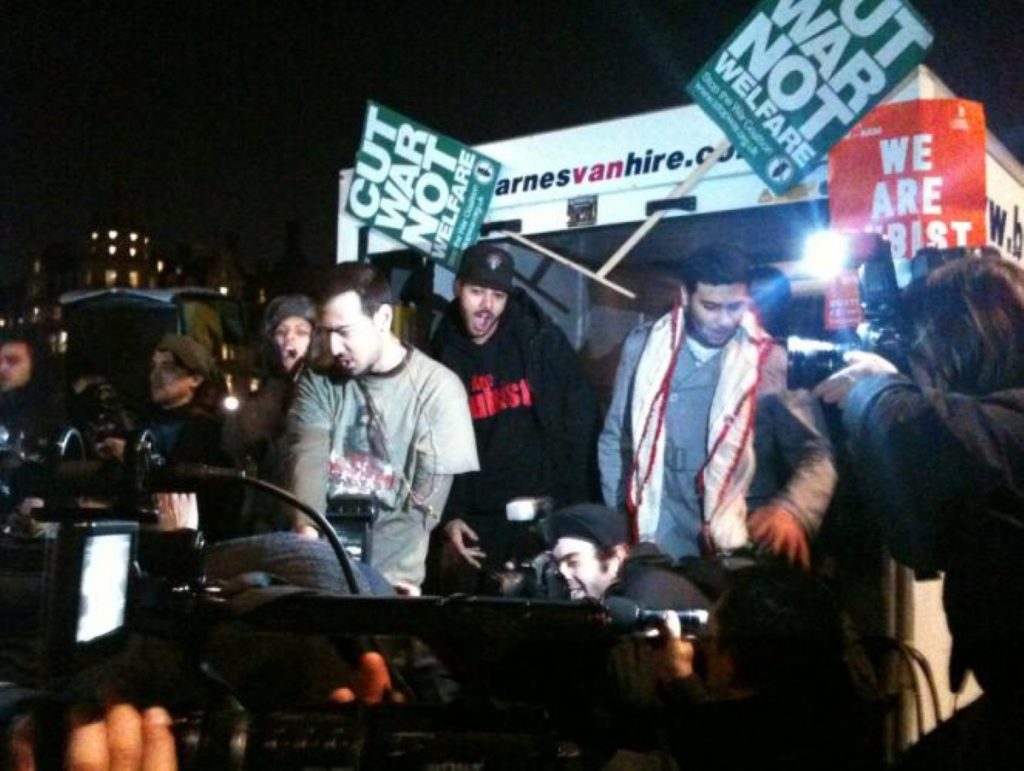Student protest returns as Commons debates cuts
By Ian Dunt
Student demonstrators returned to Parliament Square this evening, as activists fought to save an educational payment.
Around 300 protestors peacefully marched into Parliament Square before beginning a good-natured demonstration opposite Westminster Abbey and the Houses of Parliament.
As MPs debate the measure in the Commons, urban music could be heard in the halls of Westminster, as powerful sound systems dominated the streets outside parliament.


Inside the chamber, Labour opposed government plans to scrap the educational maintenance allowance (EMA) – a small payment made to young people to keep them in full-time education.
A Labour demand for the government to rethink its plans was defeated by 317 votes to 258.
Liberal Democrat deputy leader Simon Hughes, who some had expected to rebel, called on Labour to help come up with an alternative to the payment.
But shadow education secretary Andy Burnham said the payment was “worth fighting for”.
He added: “[Education secretary Michael Gove] will have to work very hard indeed to convince us that a scheme the tenth of the size will improve access to further and higher education.
“How can it possibly achieve that?”
Mr Gove replied: “You cannot spend money you do not have.
“There is no money. That is a truth no single member of the Labour party has had the courage to atone for or apologise for.”
In an emotional and bad-tempered debate, Mr Gove shouted “sit down” at MPs trying to interject during his speech.
“The secretary of state is getting very excited,” deputy speaker Lindsay Hoyle said.
“People are trying to intervene. I’ll decide when they’ve stood up for too long.”
Student protestors gathered in Piccadilly Circus at around 16:00 GMT before marching down to Parliament Square.
The Metropolitan police contacted academic institutions via email last week to pass on intelligence on localised protests.
The police also distributing a leaflet today aimed at explaining what the police operation would look like on the ground, offering advice on how to make a complaint and giving information about reporting any violent disorder.
Chief superintendent Peter Terry, from the Met’s public order branch, said: “We want protestors to have a better understanding of what to expect, what the policing operation will look like on the day and what action we could take and why, so there will be no surprises.
The leaflet reads: “The Metropolitan Police Service is committed to upholding the law and the fundamental freedoms expressed by the Human Rights Act.
“We respect the right to protest and work with people to try and ensure they can exercise their rights in a safe and crime free way.”
The leaflet lists the route the march took and says a space has been marked out on the south side of Parliament Square for a demonstration.
It continues: “In the main event you can expect to see officers in yellow jackets and a traditional police helmet or flat cap, others will wear a blue baseball cap. If violence or disorder takes place the officers may change their headwear to a helmet with a visor. The officers will revert to normal headwear as soon as it is safe to do so.
“Please be aware that when an officer is wearing a helmet it is more difficult for them to communicate and if you are not facing them they may not hear you and they may shout. All the officers will be uniquely identifiable by a series of numbers, letters or both on their epaulettes.”
The publication of the leaflet marks a new effort by police to ensure a peaceful event in central London, after several previous demonstrations deteriorated into violence.
Many activists said that police forces contained (‘kettled’) demonstrators in a knee-jerk response to the protests and that several officers were heavy-handed and violent.
Meanwhile, there were several high-profile instances of property damage and threatening behaviour from protestors.
Labour’s London Mayoral candidate Ken Livingstone said yesterday: “The Conservative-led government’s plan to scrap educational maintenance allowances will deter thousands of teenagers in London from learning new skills and gaining valuable qualifications and work experience.
“Now more than ever, students in London need our support to oppose these hugely damaging cuts yet there the silence from the mayor is deafening. It’s time Boris Johnson put the interests of students before the interests of the Conservative party.”
While student protest groups are trying to start the new year with renewed vigour, today’s demonstration is a much smaller event than that planned for January 29th, when trade unions are expected to join another day of action against tuition fees.
Some local protests ended in violence yesterday, as events took place across the country.
Clashes in Birmingham ended with allegations that one female student had been headbutted and two others punched as police intervened.

